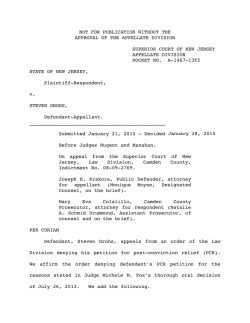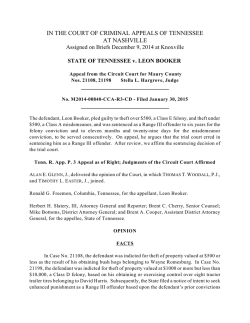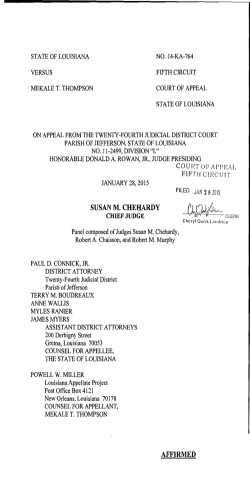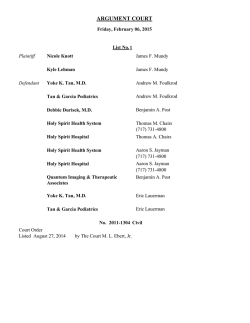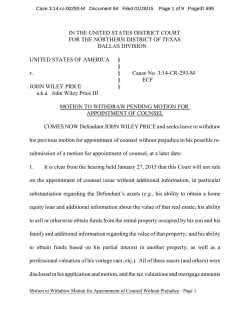
SUPREME COURT OF MISSOURI en banc
SUPREME COURT OF MISSOURI en banc STATE OF MISSOURI, Respondent, v. DAVID RUSSELL HOSIER, Appellant. ) ) ) ) ) ) ) ) ) No. SC93855 APPEAL FROM THE CIRCUIT COURT OF COLE COUNTY The Honorable Patricia S. Joyce, Judge Opinion issued February 3, 2015 David Hosier (Defendant) was charged with and convicted of first-degree murder, armed criminal action, first-degree burglary, and unlawful possession of a firearm by a felon. He was sentenced to death for the murder charge, 15 years in prison for the armed criminal action charge, 15 years for the burglary charge and seven years for the unlawful possession of a firearm charge. He appeals his conviction, alleging certain evidence should have been suppressed or was inadmissible. He further argues that there was insufficient evidence to support a conviction for burglary. This Court holds that: (1) evidence seized from Defendant’s person and car was admissible because his flight from police and the nature of the alleged Fourth Amendment violation purged the evidence of any taint of an illegal stop; (2) Defendant was not seized until he pulled his car over in response to the police; (3) there was sufficient probable cause to support a search warrant for Defendant’s apartment; (4) pictures of the guns and ammunition found in Defendant’s car were admissible because they were logically and legally relevant; (5) the victim’s statements on an application for a protective order and to her landlord concerning Defendant’s actions were admissible under the forfeiture by wrongdoing doctrine; (6) there was sufficient evidence to support a conviction for first-degree burglary; (7) the note found in Defendant’s car was authenticated by circumstantial evidence; and (8) his sentence was proportional. The judgment is affirmed. Factual Background The bodies of Angela Gilpin (Victim) and Rodney Gilpin (Husband) were found in the hallway of their apartment building. 1 The Jefferson City Police Department (JCPD) found 9-millimeter shell casings in the foyer and the apartment, and an autopsy later revealed that Victim died from gunshot wounds to the head and torso and Husband died from gunshot wounds to the chest. Victim was wearing her purse, which contained an application for a protective order from Defendant. The application stated that she and Defendant were “ex-lovers, he knows everywhere i [sic] go, who i [sic] go with, who comes to my home and is harassing me calling JCPD for no reason.” She further wrote that “he stalkes [sic] me every day, has called JCPD on me Sat. Monday.” She also 1 Although the police found two victims, this case stems only from charges brought against Defendant for Victim’s death. It does not involve charges related to Husband’s death. indicated that she was afraid because Defendant had a violent history with an ex-wife. On a separate form used for obtaining service, she indicated that Defendant had “lots of firearms.” 2 JCPD soon learned that Defendant and Victim had been involved in an “on again, off again” romantic relationship that Victim had ended when she reconciled with Husband. The apartment building was locked, and there were no signs of forcible entry. In the hours after the deaths were discovered, JCPD spoke with various people who knew the victims and Defendant, including their landlord, two neighbors and Defendant’s former employer. The landlord informed JCPD that Defendant’s apartment overlooked Victim’s apartment and that Victim had requested a new apartment because she no longer wanted to live near Defendant. The landlord relayed a copy of a letter Victim had written him stating that she had filed for a restraining order against Defendant and that she was afraid because she did not know what Defendant would “do next.” He also provided police with a criminal background check indicating that Defendant had been convicted of assault and battery in Indiana. The landlord added that he recently told Defendant that he was no longer permitted to enter Victim’s apartment building because Victim complained he had entered her apartment without permission. 3 The landlord had asked Defendant to move out by the end of September because of the growing tension. 2 Victim applied for the order of protection two weeks prior to the murder, and a hearing was set for four days prior to the murder. The record does not indicate that the hearing was held. However, Defendant’s landlord testified that a sheriff’s deputy attempted to serve Defendant with process, but Defendant was out of town. 3 Defendant used to have access to Victim’s building to do odd jobs. 3 JCPD also contacted a neighbor who had socialized with Victim the night before her death. Defendant had left several voice messages on the neighbor’s cell phone that night that were threatening toward Victim. In one message, Defendant stated that he was going to “f****** finish it. I’m tired of the s***. You don’t believe me. I’m tired of the s***.” On another occasion after Defendant and Victim broke up, Defendant told this neighbor that if he could not have Victim, no one could. A second neighbor told JCPD that Defendant had called her the night before the murders to say that he had left certain possessions on her car in case something happened. He also told her that he was going to “eliminate his problems.” The neighbor led JCPD to her car, where they found a note and a set of keys. The note was from Defendant and instructed the neighbor to call Defendant’s sister if anything happened to him. He also asked her to take care of his possessions in a storage facility. The neighbor told police that Defendant had previously stated that Victim had “f****** him over” and that he was going to “f*** her over.” JCPD also spoke with Defendant’s former employer. He told them Defendant had been “let go” because he had been harassing and stalking Victim, who had been a frequent customer. In the hours immediately following the murders, there was no response at Defendant’s apartment and his car was not in its usual parking spot. Relying on the information they learned from the landlord, the neighbor with the threatening voicemails and Defendant’s former employer, Missouri authorities applied for a search warrant for Defendant’s apartment. They found 9-millimeter ammunition and an empty box of 94 millimeter shells. They also found the schematic for a 9-millimeter STEN machine gun. They also applied for a ping order 4 to determine Defendant’s location when they applied for the search warrant. The application included an affidavit in which the swearing officer stated that Defendant “has been identified as the primary suspect in the homicide investigation” and the location information was “essential . . . to obtain key evidence relevant to the ongoing criminal investigation.” The ping order allowed police to determine Defendant’s location in real time based on the location of his cell phone. Using the ping order, JCPD determined that Defendant was traveling south through Oklahoma. They alerted law enforcement officials in Oklahoma that a “wanted car and person” was in the area. An officer spotted Defendant’s car and activated his emergency lights to pull him over. Defendant did not stop and led police on a “moderate speed chase,” evading one road block before pulling over. When he eventually stopped, he exited his car, saying, “Shoot me, and get it over with” or “end it.” They were able to put him in handcuffs and found a knife on his body. In plain view in the car, police saw a bulletproof vest, gun and pistol holder. Oklahoma authorities applied for a search warrant for Defendant’s car. In the application, the swearing officer stated that he was alerted to Defendant’s presence in Oklahoma by JCPD and that JCPD had identified Defendant as the primary suspect in the homicide investigation based on interviews with the neighbors. The application stated 4 Cell phone companies are able to determine the location of a cell phone by tracking which cell towers the phone “pings.” A cell phone will ping the nearest tower whenever it receives an incoming call or when it makes an outgoing call. Cell phones also periodically ping the nearest tower as long as the phone is activated. 5 that police were aware he was in Oklahoma based on the ping order. The swearing officer stated that Defendant had violated state law by illegally possessing a firearm and failing to yield to police lights and sirens. In searching the car pursuant to the Oklahoma warrant, police recovered two cell phones, a knife next to the driver’s seat, a bulletproof vest, 400 rounds of ammunition and 15 firearms. One of these firearms was an unloaded STEN machine gun that was capable of firing 9-millimeter ammunition. It was the only gun in the car that was not in a bag, and was later determined to be the murder weapon. They also found two notes. One note had Victim’s vehicle information written on it. The other note offered incriminating evidence that Defendant had harmed someone. It stated: If you are going with someone do not lie to them, do not play games with them, do not f*** them over by telling other people things that are not true, do not blame them for things that they have not done. Be honest with them and tell them if there is something wrong. If you do not this could happen to YOU!! People do not like being f***** with, and after so much s*** they can go off the deap [sic] end!! Had to [sic] much s***!!! Defendant was charged with first-degree murder, armed criminal action, firstdegree burglary and unlawful possession of a firearm by a felon. The jury found Defendant guilty on all counts. During the penalty phase of the trial, the government presented evidence that Defendant had assaulted his ex-wife and was convicted of assault and battery for handcuffing and beating another ex-girlfriend until she was unconscious. There was 6 other evidence that Defendant had threatened other people prior to the murder. Defendant presented mitigation evidence from his mother, sister, pastor and ex-wife. The jury recommended a death sentence after finding two statutory aggravating circumstances: (1) that Defendant had previously been convicted of a serious assault and (2) that Defendant had murdered Victim while committing another unlawful homicide. The trial court sentenced him to death on the murder charge, 15 years in prison for armed criminal action, 15 years for burglary, and seven years for being a felon in possession of a firearm. This appeal follows. 5 Evidence Seized from Defendant’s Car Was Admissible Defendant first argues the ping order used to track his location was an illegal search because it was not supported by probable cause. Consequently, he argues, the evidence seized from his car was inadmissible as fruit of the poisonous tree. His second contention is that the stop in Oklahoma was an illegal seizure, rendering the evidence inadmissible. Standard of Review When reviewing the trial court’s decision to overrule a motion to suppress, this Court considers the evidence presented both at the suppression hearing and at trial to determine whether sufficient evidence exists in the record to support the trial court’s decision. State v. Grayson, 336 S.W.3d 138, 142 (Mo. banc 2011). This Court defers to the trial court’s credibility determinations and factual findings, inquiring only whether the decision is supported by substantial evidence, and reverses only if the trial court’s 5 This Court has jurisdiction pursuant to Mo. Const. art. V, sec. 3. 7 decision is clearly erroneous. Id. Determinations of whether there was reasonable suspicion or probable cause are questions of law that are reviewed de novo. Id. Ping Order The ping order directed Defendant’s cell phone company to provide police with the real-time location information of his cell phone. JCPD used this information to track Defendant to Oklahoma, and the Oklahoma authorities relied on the ping order in applying for the search warrant for Defendant’s car. Police gathered several pieces of evidence from Defendant’s car pursuant to the Oklahoma search warrant: 15 guns, including the murder weapon, numerous rounds of ammunition, a bulletproof vest, a knife, the note with Victim’s car information and the incriminating note. Defendant filed a pretrial motion to suppress this evidence and made timely objections at trial. Missouri authorities obtained the ping order pursuant to 18 U.S.C. § 2703(d) (2006), which requires “specific and articulable facts showing that there are reasonable grounds to believe that the contents of a wire or electronic communication, or the records or other information sought, are relevant and material to an ongoing criminal investigation.” This is a lesser standard than the probable cause needed to obtain a search warrant as guaranteed by the United States Constitution and the Missouri Constitution. 6 The issue of whether police must make a probable cause showing in order to obtain real-time cell phone location data has been frequently challenged. Some courts 6 People are to be free of unreasonable searches and seizures, and no warrants shall issue but upon probable cause. U.S. CONST. amend. IV; MO. CONST. art. I, sec. 15. The Missouri provision is coextensive with the Fourth Amendment, and the same analysis applies under both provisions. State v. Lovelady, 432 S.W.3d 187, 190 (Mo. banc 2014). 8 have determined that ping orders for real-time cell phone location on public thoroughfares do not require probable cause. See, e.g., United States v. Skinner, 690 F.3d 772 (6th Cir. 2012). Others have found the ping orders may constitute a search that require a warrant supported by probable cause, but an exception applied. See, e.g., United States v. Barajas, 710 F.3d 1102 (10th Cir. 2013). Still others have found that evidence obtained from such orders is inadmissible absent a showing of probable cause. See, e.g., In re Order Authorizing Prospective and Continuous Release of Cell Site Location Records, 31 F. Supp. 3d 889 (S.D. Tex. 2014). No Missouri state court has ruled on this issue. Defendant argues that the ping order was a search, and Missouri authorities were required to make a probable cause showing. He continues that because the ping order violated the Fourth Amendment, any subsequent searches and seizures based on the illegal order were subject to exclusion as “fruit of the poisonous tree.” Not all evidence that is “fruit of the poisonous tree” must be suppressed, however. Wong Sun v. United States, 371 U.S. 471, 487-88 (1963). The relevant inquiry is whether the evidence in question “has been come at by exploitation of that illegality or instead by means sufficiently distinguishable to be purged of the primary taint.” Id. at 488; Grayson, 336 S.W.3d at 147. If the evidence has been “purged of the primary taint,” then it may be admissible. To determine if evidence has been “purged of the primary taint,” courts consider three factors: (1) the temporal proximity between the illegality and the procurement of the evidence; (2) the presence of intervening circumstances; and (3) the purpose and 9 flagrancy of the official misconduct. See Brown v. Illinois, 422 U.S. 590, 603-04 (1975); Grayson, 336 S.W.3d at 147. Even if this Court assumes without deciding whether relying on the less stringent standard of § 2703(d) to obtain the ping order violated the Fourth Amendment, the evidence was admissible because it was “purged of the primary taint.” The first factor, temporal proximity, cautions against admitting the evidence as the first attempt at stopping Defendant in Oklahoma took place about two hours after JCPD obtained the ping order. The next two factors, however, weigh strongly in favor of admitting the evidence. The second factor, the presence of intervening events, was satisfied when Defendant led police on a car chase. See Brown, 422 U.S. at 604. This was an intervening event that gave police reasonable suspicion to stop Defendant. The bulletproof vest, knife, gun and pistol holder police officers found on Defendant’s person and in plain view in his car, in addition to the information they learned from JCPD, gave them probable cause to obtain and execute a search warrant independent of the ping order. See, e.g., United States v. Dawdy, 46 F.3d 1427, 1431 (8th Cir. 1995) (holding “a defendant’s response to even an invalid arrest or Terry stop may constitute independent grounds for arrest” in a case where the defendant fled police on foot after being stopped); United States v. Garcia, 516 F.2d 318, 319 (9th Cir. 1975) (suppression not warranted when defendant fled an illegal traffic stop in his car because the flight was “voluntary conduct” so law enforcement did not exploit the illegal stop); State v. McKeehan, 894 S.W.2d 216 (Mo. App. 1995) (police were justified in stopping defendant when he fled approaching police and led police on a 10 high speed chase). The third factor in determining if the evidence was purged of its taint is the purpose and flagrancy of the official misconduct. See Brown, 422 U.S. at 604. This factor also favors admissibility. As discussed above, courts are split as to whether police must make a probable cause showing to obtain real-time cell location information under 18 U.S.C. § 2703(d). It is difficult to find fault with law enforcement here because of the unsettled nature of this point of law. Even assuming the police violated Defendant’s Fourth Amendment rights by obtaining and relying on the ping order, the evidence seized from Defendant’s car was admissible because it was “purged of the primary taint.” Oklahoma Stop Defendant’s next argument against the admissibility of the evidence found in his car also fails. He asserts that he was seized when the Oklahoma officer first activated his lights. He contends that since he was not violating any traffic laws at that time, there was no probable cause to stop him. His argument continues that, because the Oklahoma police lacked probable cause for this seizure, all the evidence seized from his car was inadmissible. Defendant urges this Court to apply the standard articulated by the Supreme Court of the United States in United States v. Mendenhall to find that he was seized the moment the officer activated the emergency lights in Oklahoma. 446 U.S. 544 (1980). In Mendenhall, DEA agents approached the defendant in an airport because she fit the profile of a drug courier. Finding that the defendant was not seized when police first 11 approached her, the Supreme Court held that a person is seized for Fourth Amendment purposes only if, in view of all the circumstances surrounding the incident, a reasonable person would have believed she was not free to leave. Id. at 554. Several years later, in California v. Hodari D., the Supreme Court held that a person is not seized until the police subject the person to physical force or the person submits to a show of police authority. 499 U.S. 621, 626 (1991); see also State v. Deck, 994 S.W.2d 527, 535 (Mo. banc 1999). In doing so, it noted that the Fourth Amendment “does not remotely apply . . . to the prospect of a policeman yelling ‘Stop, in the name of the law!’ at a fleeing form that continues to flee.” Hodari D., 499 U.S. at 626. Although Mendenhall established that the test for whether a person is seized is an objective test, Hodari D. further refined the test. See id. at 627-28. Defendant acknowledges that under Hodari D., he was not seized until he submitted to police authority by stopping his car, but argues that this Court should reject the Hodari D. analysis in this case. This Court finds Hodari D. controlling here. See, e.g., Deck, 994 S.W.2d at 535. By leading police on a “moderate speed chase,” Defendant violated numerous traffic laws and provided Oklahoma authorities with probable cause to stop him for those violations. Because Defendant was not seized until he yielded to police by stopping his car, and because there was probable cause to stop him for the traffic violations, the stop in Oklahoma did not violate the Fourth Amendment. As the evidence seized from his car was the result of a lawful stop, it was admissible. 12 Evidence Seized from Defendant’s Apartment Was Admissible Defendant next argues that the evidence seized from his apartment should have been suppressed because there was not sufficient probable cause to issue a warrant. When determining whether there is probable cause to issue a search warrant, a court looks at the totality of the circumstances to decide whether there is a fair probability that contraband or evidence of a crime will be found in a particular place. Illinois v. Gates, 462 U.S. 213, 238 (1983). The decision should be based on the information in the affidavit, including the “basis of knowledge” and truthfulness of the persons providing hearsay information. Id. A court is limited to looking only within the four corners of the search warrant application. State v. Laws, 801 S.W.2d 68, 70 (Mo. banc 1990). This Court gives great deference to the initial judicial determination of whether there was probable cause to issue a warrant. State v. Neher, 213 S.W.3d 44, 49 (Mo. banc 2007). Accordingly, a decision on a motion to suppress evidence for an insufficient warrant is reviewed for clear error. Id. There was probable cause here. Approximately four hours after Victim’s death was discovered, Missouri authorities applied for a search warrant for Defendant’s apartment. In the application, the detective stated that he arrived at the scene to find the bodies of two victims and spent cartridges from a 9-millimeter weapon. He included the following information in his sworn affidavit: (1) the neighbor had voice messages on her cell phone from Defendant with a “threatening tone” toward Victim; (2) Victim told the landlord that Defendant was threatening her and that she wanted to move because she was afraid of Defendant; (3) the landlord had told Defendant he needed to move out; 13 (4) court records indicated that Victim had applied for an order of protection from Defendant; and (5) Defendant’s former employer had fired Defendant for harassing and stalking Victim. The police searched Defendant’s apartment pursuant to the search warrant. They recovered an empty box of 9-millimeter shells, 9-millimeter ammunition, and a template for a 9-millimeter STEN machine gun, in addition to other gun-related accessories. Defendant argues the affidavit did not supply the requisite probable cause for numerous reasons. First, he contends the application did not identify the neighbor who relayed the threatening voice messages so there was nothing to substantiate her veracity, and the officer did not indicate whether he listened to the messages. Additionally, it did not include when Defendant allegedly left the voice messages or the content of the messages. He identifies similar issues with the landlord’s statements, namely that the application did not state what threats Defendant had allegedly made to Victim or give details related to how Victim had received the threats that made her want to move. He argues that the application did not include the date that Victim had applied for the order of protection, nor did it include when Defendant had been fired from his job or who determined that Defendant had been stalking and harassing Victim. These arguments are unpersuasive. A court can judge the veracity of an informant by determining whether the information is corroborated. See Neher, 213 S.W.3d at 50. The neighbor, the landlord, Defendant’s former employer and Victim’s application for an order of protection all indicated that there was an ongoing and present concern that Defendant had been threatening or harassing Victim. While the affidavit does not set out 14 a timeline of these threats or the content of the threats, it does identify four different sources indicating that Defendant had been threatening, stalking or harassing Victim. Based on the information in the affidavit, there was probable cause to believe there would be evidence of the crime in Defendant’s home. Evidence of Other Weapons and Ammunition Unrelated to the Crime During the trial, the state introduced photos of 15 weapons and several rounds of unspent ammunition recovered from Defendant’s car, even though only one was identified as the murder weapon. He argues the 14 weapons and unspent ammunition that were not alleged to be used during the crime were inadmissible because they were inherently prejudicial and did not have any probative value. A trial court has wide discretion in deciding whether to admit evidence, and its decision will only be overturned for an abuse of discretion. See State v. Anderson, 76 S.W.3d 275, 276 (Mo. banc 2002). For evidence to be admissible, it must be logically and legally relevant to the case. Id. Evidence is logically relevant if it has probative value, meaning it tends to make the existence of a material fact more or less probable. Id. Evidence is legally relevant if its probative value outweighs any costs of using the evidence, such as unfair prejudice. Id. In this case, the 14 guns and ammunition that were not alleged to have been used to commit the murder were logically relevant because they were found in Defendant’s car during his flight from Jefferson City directly after the murders. Evidence of flight is admissible to show consciousness of guilt. See State v. Johns, 34 S.W.3d 93, 112 (Mo. banc 2000). Moreover, “the methodology of . . . flight is probative as to the quality and 15 depth of this consciousness.” Id. (finding evidence that defendant held someone hostage when confronted by police was admissible in a murder trial in which the victim was not also the hostage). The fact that Defendant left Jefferson City right after the murders occurred and did so armed with 14 other guns and ammunition was probative of his guilt. Defendant argues that the evidence was inadmissible because its prejudicial effect outweighed its probative value. He relies on a line of cases that stand for the principle that “weapons unconnected with either the accused or the offense for which he is standing trial lack any probative value and their admission into evidence is inherently prejudicial.” See, e.g., State v. Grant, 810 S.W.2d 591, 592 (Mo. App. 1991). These cases, however, are distinguishable from the instant case because the weapons and ammunition were directly connected to Defendant and the first-degree murder charge. They were found in his possession shortly after the murders took place. Cf. State v. Krebs, 106 S.W.2d 428, 429 (Mo. 1937) (a gun found on defendant that was unlike the weapon involved in the crime was inadmissible when defendant was arrested two months after the incident). Defendant was the only passenger in the car and did not claim they belonged to someone else. Cf. State v. Perry, 689 S.W.2d 123, 124-25 (Mo. App. 1985) (gun was inadmissible when it was unlike the one used in the crime and it was found in a car that defendant borrowed from his mother and was riding in as a passenger). Additionally, the weapons and ammunition were related to the crime charged because they were part of his direct flight from the crime scene and tended to show a consciousness of guilt. Cf. State v. Holbert, 416 S.W.2d 129, 132-33 (Mo. 1967) (when defendant was charged with carrying a concealed weapon, evidence of two other guns 16 unrelated to the charge were inadmissible). The 14 other weapons and ammunition were highly probative to show consciousness of guilt. Further, any prejudicial effect they would have had was minimized by admitting only photographs of the evidence, not the guns and ammunition themselves. Additionally, numerous other weapons that were found in Defendant’s apartment and storage shed were introduced at trial, eliminating any prejudicial value of the weapons from his car. 7 Any prejudicial effect the photographs may have had did not outweigh the probative value of the evidence. It was not an abuse of discretion to admit them. Victim’s Statements Were Admissible Defendant next argues that the admission of Victim’s statements on the application for an order of protection violated the Sixth Amendment confrontation clause. He also argues that the letter she wrote and statements she made to the landlord should have been excluded as hearsay. Whether testimony violates the confrontation clause is a question of law this Court reviews de novo. State v. Justus, 205 S.W.3d 872, 878 (Mo. banc 2006). This Court reviews a decision to admit hearsay evidence for an abuse of discretion. State v. Bell, 950 S.W.2d 482, 484 (Mo. banc 1997). Order of Protection Statements At trial, the state introduced the Victim’s application for an order of protection against Defendant that was found on her body the night of the murders. Some statements 7 Defendant does not challenge the admissibility of any of the weapons found in his apartment and storage shed in this appeal. 17 from the application were read to the jury, although it was not published to the jury. The prosecutor relied on the following statements from the document during his closing argument: “Ex-lovers. He knows everywhere I go, who I go with, who comes to my home, and is harassing me, calling JCPD for no reason. . . . He stalks me every day, has called JCPD on me Sat., Monday.” The confrontation clause of the Sixth Amendment provides that “[i]n all criminal prosecutions, the accused shall enjoy the right to . . . be confronted with the witnesses against him.” U.S. CONST. amend. VI. The Missouri Constitution also provides that, “in criminal prosecutions the accused shall have the right to . . . meet the witnesses against him face to face.” MO. CONST. art. I, sec. 18(a). Under the confrontation clause, a court should exclude testimonial hearsay statements of a witness who does not appear at trial unless the witness was unavailable to testify and the defendant had a prior opportunity to cross-examine the witness. Crawford v. Washington, 541 U.S. 36, 53-54 (2004). A statement is testimonial if it is given while there is no emergency in progress and it is made for the purposes of establishing or proving past events relevant to later criminal prosecution. Davis v. Washington, 547 U.S. 813, 822, 829 (2006). Assuming the statements were inadmissible under the confrontation clause, they are admissible under the forfeiture by wrongdoing doctrine. This doctrine provides that if the defendant procured the declarant’s absence with the intent of preventing the declarant from testifying against the defendant, then the declarant’s hearsay statements may be admissible. Giles v. California, 554 U.S. 353 (2008). Giles addresses the intersection of 18 the confrontation clause and the forfeiture by wrongdoing doctrine in the context of abusive relationships: Acts of domestic violence often are intended to dissuade the victim from resorting to outside help, and include conduct designed to prevent testimony to police officers or cooperation in criminal prosecutions. Where such an abusive relationship culminates in murder, the evidence may support a finding that the crime expressed the intent to isolate the victim and to stop her from reporting abuse to the authorities or cooperating with a criminal prosecution – rendering her prior statements admissible under the forfeiture doctrine. Earlier abuse, or threats of abuse, intended to dissuade the victim from resorting to outside help would be highly relevant to this inquiry, as would evidence of ongoing criminal proceedings at which the victim would have been expected to testify. Id. at 377 (emphasis added). Shortly after Giles was decided, this Court applied the forfeiture by wrongdoing doctrine in State v. McLaughlin, 265 S.W.3d 257 (Mo. banc 2008). In McLaughlin, the defendant was on trial for the first-degree murder of his ex-girlfriend. In the course of ending their relationship, the victim had filed for multiple protective orders against the defendant. At the time of her death, there were pending abuse and burglary charges against him in which she was the complaining witness. This Court found that the victim’s statements regarding requests for police protection and the defendant’s harassing and threatening conduct towards her was admissible under Giles. Id. at 272. It noted that there was ample evidence that defendant had killed the victim to keep her from testifying, such as the fact that she made the statements while trying to end their relationship and that she had sought various orders of protection. Id. at 273 n.10. 19 As in McLaughlin, the forfeiture by wrongdoing doctrine applies in this case. There was ample evidence from the neighbors, the landlord, and Defendant’s former employer that Defendant had been harassing Victim before her death and that Victim had sought judicial intervention. While there was not an active order of protection against Defendant, Victim had applied for a protective order, and Defendant was not served because he was out of town. Under Giles and McLauglin, Victim’s statements were admissible under the forfeiture by wrongdoing doctrine as Defendant’s actions were intended to cause Victim to be unavailable to testify. Victim’s Statements to the Landlord Defendant also argues that the statements Victim made to the landlord about Defendant and the letter she sent the landlord were inadmissible hearsay. The landlord testified that Victim told him that Defendant had entered her apartment without her permission, which led the landlord to tell Defendant he no longer had permission to enter Victim’s apartment building. In the letter, Victim requested a new apartment because she was afraid of Defendant. 8 8 The trial court admitted a redacted copy of the letter, which read: Dear Dennis, This is Angie Gilpin, 1100 W. High apt. 2. I am writing you ,to [sic] inquire as to weather [sic] you may have any other apartment rentals anywhere else in town. I can no longer live next door to David Hosier. . . . I have gone to the Court House and filled [sic] for a restraining order. .... Anyway, If [sic] you have anything else, I would be interested in looking. I have liked my apartment, and renting from you. I’m sorry for all the B.S. Believe me, he scares me. I don’t know what he will do next. Sincerely, Angie 20 As discussed above, these statements were admissible under the forfeiture by wrongdoing doctrine. Sufficient Evidence Supported Defendant’s Burglary Conviction Defendant next argues there was insufficient evidence to convict him of firstdegree burglary. Appellate review of sufficiency of the evidence is limited to whether the state has introduced sufficient evidence from which a reasonable juror could have found each element of the crime beyond a reasonable doubt. State v. Nash, 339 S.W.3d 500, 508-09 (Mo. banc 2011). This Court does not reweigh the evidence but, rather, considers it in the light most favorable to the verdict and grants the state all reasonable inferences. Id. at 509. A defendant commits first-degree burglary when “he knowingly enters unlawfully or knowingly remains unlawfully in a building or inhabitable structure for the purpose of committing a crime therein.” See section 569.160. 9 A person enters or remains unlawfully on a property “when he is not licensed or privileged to do so.” Section 569.010(8). Defendant argues there was insufficient evidence to convict him of burglary because there were no signs of forced entry at the crime scene and it is possible that, if Defendant was present there, someone invited him into the building. While that is possible, it is not the test. The evidence showed that the landlord expressly told Defendant he was no longer allowed into Victim’s building. From the landlord’s testimony and Victim’s body in the hallway of her building, there was sufficient evidence 9 All references are to RSMo 2000. 21 from which a reasonable juror could find that Defendant entered the building unlawfully. The evidence further showed that Defendant asked his neighbor to call his family and check on his storage locker “in case something happened” and then left Jefferson City directly after the murders. This was sufficient evidence from which a reasonable juror could find that Defendant entered the building with the intent to commit a murder. Accordingly, there was sufficient evidence that Defendant committed first-degree burglary. Note Found in Defendant’s Car was Admissible Defendant finally argues that the note the police found in his car was inadmissible because the state did not prove that Defendant wrote it and, therefore, it was not authenticated. As a result, he argues, it was irrelevant and hearsay. The note read: If you are going with someone do not lie to them, do not play games with them, do not f*** them over by telling other people things that are not true, do not blame them for things that they have not done. Be honest with them and tell them if there is something wrong. If you do not, this could happen to YOU!! People do not like being f***** with, and after so much s*** they can go off the deep end!! Had to [sic] much s***!!! Police found this note in Defendant’s car when they searched it in Oklahoma, where he fled after the murders. The note was handwritten, but it was undated and unsigned. Whether there was a sufficient foundation to admit evidence is within the trial court’s broad discretion, and the trial court’s decision is reviewed for an abuse of discretion. State v. Copeland, 928 S.W.2d 828, 846 (Mo. banc 1996), overruled on other grounds by Joy v. Morrison, 254 S.W.3d 885 (Mo. banc 2008). Before a document can 22 be admitted into evidence, the proponent must lay the foundation for the document, including authenticity. Id. A document can be authenticated by circumstantial evidence. See id. In this case, circumstantial evidence authenticated the note. It was found in Defendant’s car that had been in continuous flight from the murder scene. It was written on the same type of paper as the note he left on his neighbor’s car. The sentiment of the note was consistent with communications about his relationship with Victim to his neighbors and the statements he made to police to “just end it” when he finally stopped his car. The trial court did not abuse its discretion in admitting it. Proportionality This Court has an independent duty to review each case in which a defendant is sentenced to death. Section 565.035. This statute requires this Court to look at three factors: (1) whether the sentence was imposed under the influence of passion, prejudice, or any other arbitrary factor; (2) whether the evidence supports the jury’s finding of statutory aggravating factors as defined in section 565.032; and (3) whether the sentence of death is excessive or disproportionate to the penalty imposed in similar cases, considering the crime, the strength of the evidence and the defendant. Section 565.035.3. First, this Court looks at whether the sentence was imposed under the influence of passion, prejudice or any arbitrary factor. Defendant has not argued that it was, and there is nothing in the record that leads this Court to find the jury recommended the death penalty for any reason aside from the evidence presented. 23 Second, this Court looks to whether the evidence supported the finding of aggravating circumstances. Section 565.032 outlines the statutory aggravating circumstances that would justify a fact finder to impose the death penalty. Those factors include that the defendant had one or more serious assaultive criminal convictions and that the murder was committed while the offender was engaged in the commission of another unlawful homicide. Section 565.032.2(1)-(2). These were the factors the jury found in this case, and there was evidence to support these findings. The government showed that Defendant had been previously convicted for assault and battery in 1993 when he handcuffed another girlfriend and beat her until she passed out. Additionally, Victim’s murder was committed while Defendant was engaged in the murder of Husband. The last factor is whether the sentence was proportional to the penalty imposed in similar cases, considering the crime, the strength of the evidence and the defendant. The death penalty has been assessed in cases involving multiple victims. See, e.g., State v. Wolfe, 13 S.W.3d 248 (Mo. banc 2000); State v. Johnson, 968 S.W.2d 123 (Mo. banc 1998); State v. Ramsey, 864 S.W.2d 320 (Mo. banc 1993); State v. Mease, 842 S.W.2d 98 (Mo. banc 1992). It has also been imposed in cases where the defendant had prior assaultive convictions. See, e.g., State v. McFadden, 369 S.W.3d 727 (Mo. banc 2012); State v. Davis, 318 S.W.3d 618 (Mo. banc 2010); State v. Barton, 240 S.W.3d 693 (Mo. banc 2007). This Court does not find Defendant’s sentence to be disproportionate. This Court independently researched cases that resulted in life imprisonment without the possibility of probation or parole. No similar cases involving the stalking and 24 harassment of the victim, the murder of both the victim and her husband by multiple gunshots, and a police chase in another state have been identified which would support a finding that his death sentence is disproportionate. The imposition of the death penalty meets the statutory requirements. Conclusion The trial court’s judgment is affirmed. _________________________ Mary R. Russell, Chief Justice All concur. 25
© Copyright 2025
